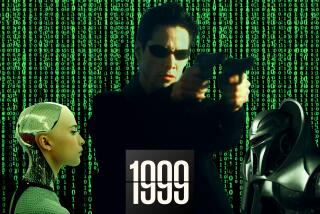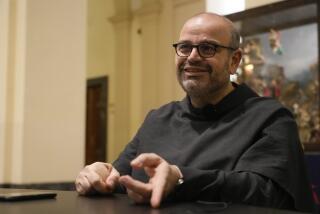Philosopher Bytes Off More Than Most of Us Can Chew
- Share via
Take the 405 South to Long Beach, hang a few turns, and you’re at the airy garden apartment of Michael Heim, a man on the cutting edge of a profession for which there is virtually no demand.
Let’s face it, when did you last hear anyone holler, “Get my philosopher on the phone--and fast!”
But that doesn’t bother Heim, who sees his calling as “sexy, magical, passionately of our time.” He says the issues he raises about life’s meaning in the coming, computer-dominated era and the questions he asks (mostly of himself) might just help clarify (at least for him) the future of mankind.
Yes, but what do philosophers do in 1992 when philosophy seems to rank right up there with sheepherding in its relevance to modern life?
“Most teach the classic texts,” he concedes, “but I would rather be it than teach it. My notion has always been that just as architect students become working architects and law students become lawyers, I would become a working philosopher.”
So he pedals around Long Beach on his bike (his wife uses the family car for work), asking the great questions that Aristotle and Plato asked a few millennia ago: “What is reality? What is a good person? What is the good life?” And from his hip pocket he pulls a tiny computer on which he writes whatever responses occur.
They occur with such unnerving rapidity, he says, that he sometimes has to hit his mental brakes to slow down the pace. “I’m way, way out there,” he admits with a bashful grin.
At 47, Heim is a computer programming expert with a Ph.D. in philosophy (he studied at the University of Freiburg, Germany, with the eminent philosopher Martin Heidegger). And he has a laundry list of technologically sophisticated clients who seek his thoughts. He founded the Long Beach Virtual Reality Group in 1991, and will lecture on technology’s effect on humanity in Denmark this fall, at the invitation of the government.
His first book, “Electric Language,” studies the effects of word processing on how we think. His next book, “The Metaphysics of Virtual Reality,”--to be published in February--explores the effects of new technology on the human psyche.
And where Heim goes now, we’ll all go sooner or later, he says. It is inevitable. It is already sucking us in.
For the first time in history, he says, we must all deal with a new layer of space and reality, both generated by computers. We spend increasing amounts of time in this electronic layer of life, he says, though most of us don’t think about it or question its effects.
At the simplest level, when we worry about “the place” where our credit information is stored, we are talking of electronic space as if it were physical space, and feeling techno-stress created by the computer.
At more complex levels, he says, the electronic layer increasingly stands between us and what we used to perceive as real. Modern soldiers, for example, do not kill real people anymore. They “kill” computer-generated images that tell precisely where the real people are.
Surgeons and dentists will soon operate on computer--generated images of their patients, while robots do the hands-on stuff, Heim says.
So how do we deal with this electronic layer that has come between man and what used to be considered real life? What does it do to the mind, to the concept of what is real and what is not, to the essential connections between human beings, and to the connection between man and machines?
Heim doesn’t claim to know; he spends his life trying to find out. And so far, he’s only touched the tip of the iceberg.
“The next step is for humans to step totally through the looking glass, to have our whole bodies present in computerized space,” he says.
It’s already happening with “virtual reality,” Heim says.
In fact, his special interest these days is “trying to get at the essence of what virtual reality is, what its vision could be for humanity.”
VR is a multi-dimensional environment, he explains, that humans “walk into” when they wear specially created electronic helmets, suits, or gloves--or use a special treadmill.
The environment programmed into the computer can be anything at all--a forest, a city, a building, a single room. Wear the special equipment and you experience yourself as being totally “inside,” the environment, as if you were literally walking, riding or flying through.
You can stop wherever you wish, turn to see whatever you want, and experience each place from every angle, just as you would see different things in real life every time you move your body or your head. Depending on what is programmed, he explains, you could look for birds in a forest, specific flowers or travel through each street of an entire city, going through whatever doors you wish.
A Japanese department store already uses virtual reality to help customers plan their kitchens, Heim says. The customer puts on electronic gear and “walks through” the kitchen as planned. By moving around “inside,” the customer might find that perhaps a drawer or appliance is not conveniently placed.
Americans are starting to use virtual reality too, Heim says. At UCLA, a virtual reality system is helping to “rebuild” Los Angeles after the riots.
In New York, an art show of virtual reality environments recently opened to the public.
In the Cerritos and Sherman Oaks malls, entertainment arcades feature virtual reality games.
And in Chicago this week, musician and scientist Jaron Lanier, 32, gave a live performance on virtual instruments, which he describes as instruments that “look real, feel real and sound real, but which only exist inside virtual (electronic) space and are unlike any instruments found in the physical world.”
Lanier, who coined the term virtual reality and founded VPL Research Inc., a pioneer manufacturer of virtual reality systems, says philosophers like Heim are crucial in a world that is moving so fast in such utterly new directions.
“A society must not be so self-important that it radically changes itself and the whole universe without considering the meaning of it all,” Lanier says.
A big question for Heim these days is how human beings should be represented in these virtual worlds.
“Should I be able to see only my body, not my face?” Heim asks.
“In the real world, a person is a headless awareness. You can see your own body but not your own face--unless you have a mirror,” he explains.
So in cyberspace, should that be what one’s identity is like? What would happen if you could see your body, including your head, as you walk through cyberspace? How would this affect your actions, your movement, your orientation?
Does anyone really care?
Aren’t the realities of life and death unchanged, with or without computers?
“I’m trying to show how no, you can’t just return to an ordinary reality. Because we’re introducing something that is going to change the holistic picture of our lives, change the very reality.
“We once thought the planet stayed the same, that it was a permanent, fixed reality no matter what we did. But we now see that if we use too much hair spray, we change the ozone level,” which changes the planet’s reality.
“I believe reality shifts and changes. That is a major question with which philosophers always grapple,” Heim asserts.
But he’s not sure , of course. “It’s the tension of trying to prove all this that keeps me going,” he says.
There is one thing of which he is unequivocally certain:
“The computer is our destiny, “ Heim says, his pale blue eyes suddenly aglow.
“The bright young people know it. That’s where their erotic impulse is, their drive to create what will last long after they are dead. I think each epoch has its madness that drives it to be divine. The Middle Ages had cathedrals, the Greeks had temples. And technology is us.”
More to Read
Sign up for our Book Club newsletter
Get the latest news, events and more from the Los Angeles Times Book Club, and help us get L.A. reading and talking.
You may occasionally receive promotional content from the Los Angeles Times.










